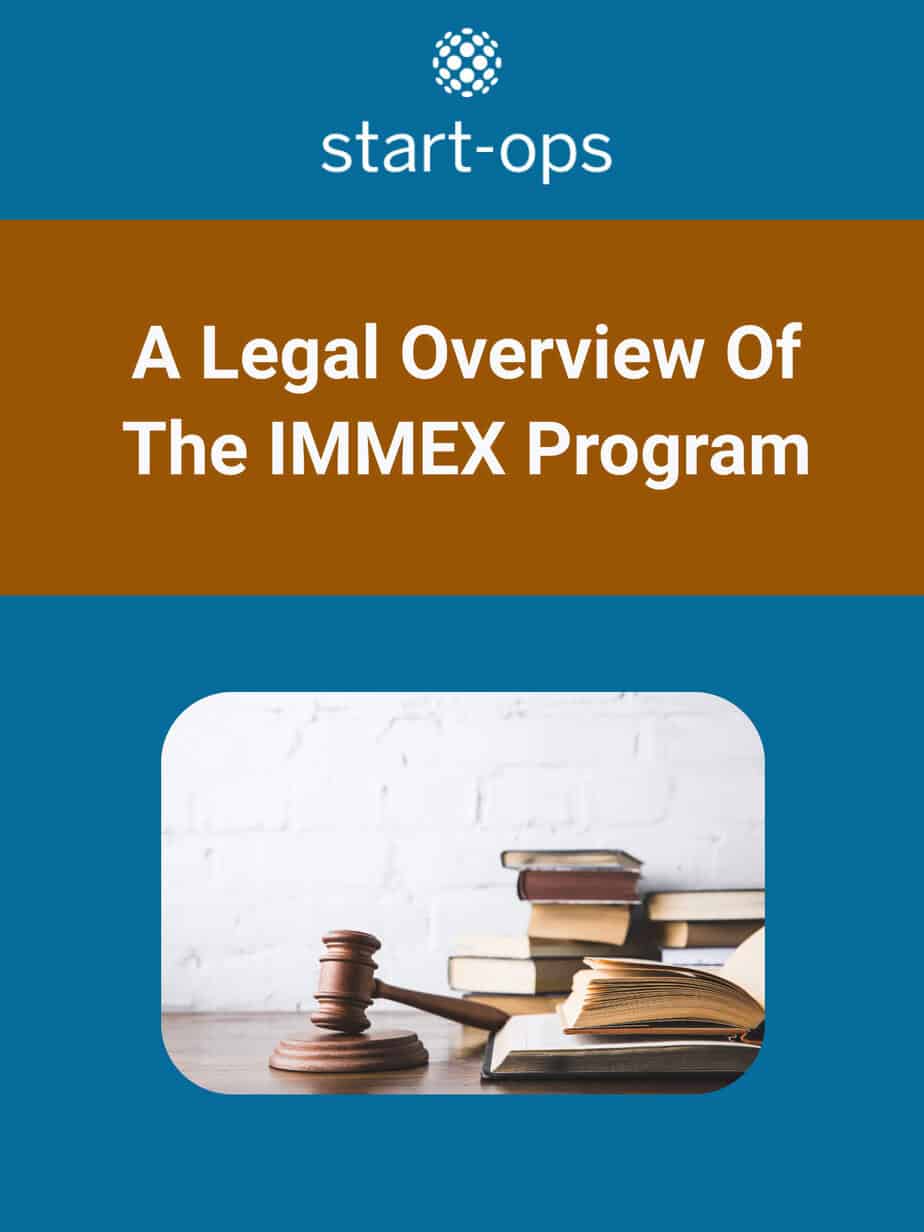Starting a manufacturing operation in Mexico is a powerful strategic move for global businesses. At the heart of this strategy lies the IMMEX program, a sophisticated framework designed to position Mexico as a premier hub for export manufacturing. However, to leverage the program’s full potential, one must understand that it does not operate in isolation. It is a legal construct deeply interwoven with a complex web of Mexican laws and regulations that govern everything from customs and taxes to labor and corporate structure.
For business leaders and investors, viewing IMMEX solely as a “duty-free” program is a critical oversimplification. True success and long-term compliance depend on a holistic understanding of the entire legal ecosystem that underpins it. Missteps in one area of law can have cascading consequences across the entire operation, jeopardizing financial benefits and even the legal right to operate.
This guide provides a clear, authoritative overview of the key laws and regulations that constitute the legal framework of the IMMEX program. We will dissect the primary decree and explore the essential supporting legislation that every IMMEX holder must master to ensure a successful, secure, and fully compliant operation in Mexico.
The Foundational Pillars: The IMMEX Decree and the Customs Law
At the center of the IMMEX universe are two foundational pieces of legislation: the IMMEX Decree itself and Mexico’s Customs Law. Together, they establish the “what” and the “how” of the program.
1. The IMMEX Decree (Decreto para el Fomento de la Industria Manufacturera, Maquiladora y de Servicios de Exportación)
This is the primary governing document that formally creates and defines the IMMEX program. Published by the Federal Government, the decree lays out the program’s core objectives, benefits, obligations, and the different modalities under which a company can operate.
Key Provisions:
-
Objective and Benefits: The decree’s primary objective is to strengthen Mexico’s national economy by providing a mechanism for companies to temporarily import goods—such as raw materials, components, and machinery—without paying the General Import Tax (IGI) or Value-Added Tax (VAT), provided those goods are used in an industrial or service process for subsequent export.
-
Operational Modalities: It defines the different types of IMMEX programs a company can apply for, including the most common:
-
IMMEX Industrial: For companies that perform an industrial transformation or manufacturing process.
-
IMMEX Shelter: For companies that provide a full administrative infrastructure to a foreign entity, absorbing the legal and fiscal liability.
-
IMMEX Services: For companies providing services to export-oriented goods (e.g., product repair, packaging, or inspection).
-
-
Obligations: The decree outlines the fundamental obligations of an IMMEX holder. These include exporting the finished products within the legally specified timeframes (typically 18 months for most raw materials), maintaining meticulous inventory control, and submitting annual reports on all foreign trade operations.
The IMMEX Decree is the constitution of your program. It grants you the rights and benefits but also imposes the core responsibilities that you are legally bound to uphold.
2. The Customs Law (Ley Aduanera)
If the IMMEX Decree is the “what,” the Customs Law is the “how.” This comprehensive law, enforced by the Tax Administration Service (SAT), governs the physical entry and exit of all goods across Mexico’s borders. For IMMEX companies, it is the operational rulebook for every import and export.
Key Provisions:
-
Temporary Import Regime: The Customs Law provides the detailed legal definition of the “temporary importation” customs regime (régimen de importación temporal), which is the mechanism IMMEX companies use. It specifies the legal timeframes that different types of goods can remain in Mexico.
-
Customs Declarations (Pedimentos): It mandates the use of a formal customs declaration, known as a pedimento, for every single import and export transaction. This document contains detailed information about the goods, their value, classification, origin, and the customs regime under which they are being processed.
-
Inventory Control (Annex 24): Crucially, the Customs Law mandates that companies operating under temporary import regimes must maintain an automated inventory control system. The specific requirements for this system are detailed in the “General Rules on Foreign Trade” in a section famously known as Annex 24. This system must track every imported component from its arrival to its “discharge” through export, waste, or virtual operation. Failure to maintain a compliant Annex 24 system is one of the most severe compliance violations an IMMEX company can commit.
The Customs Law is the operational backbone of your IMMEX program. It dictates the day-to-day procedures that ensure your physical goods are aligned with your legal permissions.
The Supporting Legal and Regulatory Framework
Beyond the two main pillars, several other laws and regulations are essential for a compliant operation. These govern taxes, labor, corporate structure, and more.
3. The General Rules on Foreign Trade (Reglas Generales de Comercio Exterior – RGCE)
Published annually by the SAT, the RGCE is the highly detailed operational manual for foreign trade. While the Customs Law provides the legal framework, the RGCE provides the specific, granular procedures. For IMMEX companies, this is where you find the fine print on how to execute compliance tasks, including the detailed data requirements for Annex 24 and the specific procedures for obtaining certifications. The RGCE is a dynamic document, and staying current with its annual updates is essential.
4. The Value-Added Tax Law (Ley del IVA)
The interaction between IMMEX and the VAT Law is a critical financial and compliance matter. A 2014 tax reform fundamentally changed this relationship. Prior to the reform, IMMEX companies were largely exempt from paying VAT on temporary imports.
Today, the VAT Law mandates that the 16% VAT is applicable to all imports. However, companies can avoid the upfront cash payment of this tax by obtaining a specific VAT & IEPS Certification. This certification, granted by the SAT to companies that demonstrate a high level of compliance, provides a 100% fiscal credit on the VAT.
This makes obtaining the certification non-negotiable for any competitive IMMEX operation. The process and benefits are directly linked to another famous regulatory section: Annex 31, which is the SAT’s system for controlling the credits and debits of VAT for certified companies. Without this certification, a company would face an immense cash flow burden, having to pay the 16% VAT on all imports and then apply for a refund.
5. The Federal Labor Law (Ley Federal del Trabajo)
Any IMMEX operation, regardless of its modality, must adhere strictly to Mexico’s Federal Labor Law. This is a robust and comprehensive legal framework that is highly protective of employees’ rights. Key areas of compliance include:
-
Hiring and Contracts: Proper documentation for employment contracts.
-
Wages and Hours: Adherence to minimum wage laws, maximum work hours, and overtime payment rules.
-
Benefits: Mandatory benefits including social security (IMSS) enrollment, paid holidays, vacation premiums, and an annual bonus (aguinaldo).
-
Profit Sharing (PTU): A constitutional mandate requiring companies to distribute 10% of their annual pre-tax profits among their employees.
-
Termination: Strict procedures and calculations for severance payments (finiquito or liquidación).
Non-compliance with labor law carries significant financial and reputational risk.
6. The General Law of Commercial Companies (Ley General de Sociedades Mercantiles)
For companies choosing the IMMEX Industrial modality, this law is foundational. It governs the incorporation and operation of legal entities in Mexico. Before applying for an IMMEX program, a company must first be legally constituted in Mexico, most commonly as a Sociedad de Responsabilidad Limitada (S. de R.L.) or a Sociedad Anónima (S.A.). This involves drafting articles of incorporation, registering with the Public Registry of Commerce, and obtaining a federal tax ID (RFC).
Conclusion: A Holistic Approach to Compliance
Success under the IMMEX program is an exercise in multi-disciplinary legal mastery. It is impossible to isolate customs compliance from tax obligations, or to separate production from labor and environmental law. Each piece of legislation is a thread in an interconnected legal fabric.
An error in your Annex 24 inventory system (Customs Law) can jeopardize your VAT Certification (VAT Law), leading to massive tax liabilities. A failure to comply with labor regulations (Federal Labor Law) can result in costly lawsuits and operational disruptions.
Navigating this complex landscape requires more than just a good production plan; it demands expert legal and administrative guidance. Understanding this legal overview is the first step for any business leader looking to build a resilient, profitable, and enduring manufacturing operation in Mexico. The companies that thrive are those that respect the complexity of this framework and invest in the expertise needed to master it.



Add your first comment to this post